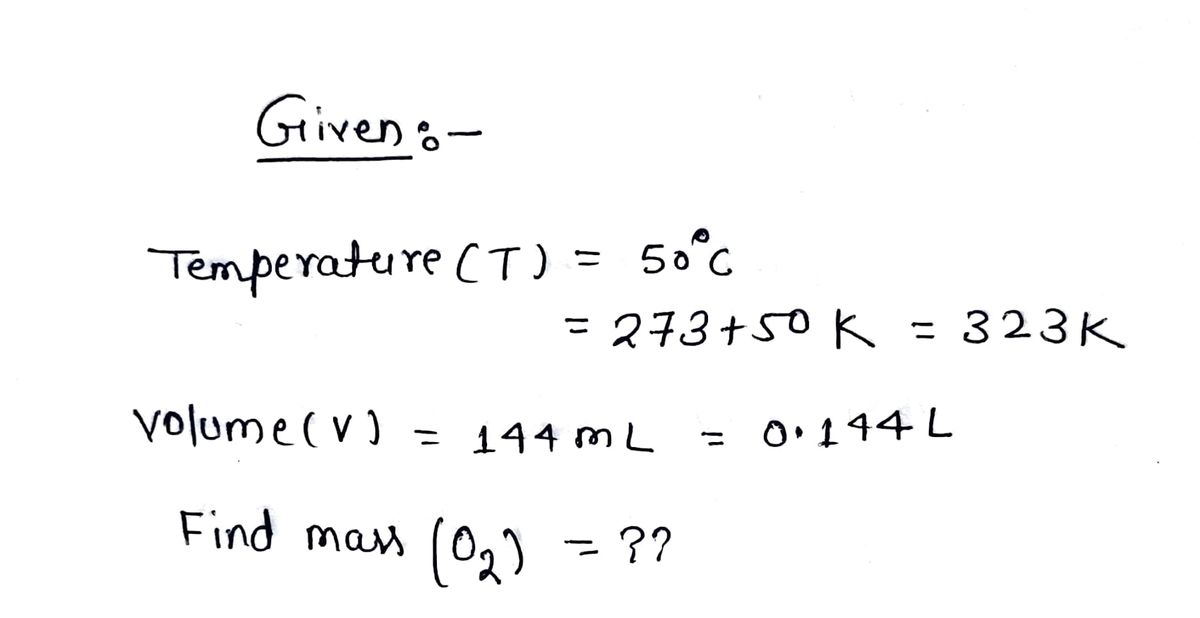Sometimes in lab we collect the gas formed by a chemical reaction over water (see sketch at right). This makes it easy to isolate and measure the amount of gas produced. Suppose the O₂ gas evolved by a certain chemical reaction taking place at 50.0 °C is collected over water, using an apparatus something like that in the sketch, and the final volume of gas in the collection tube is measured to be 144. mL. collected gas water chemical reaction. Sketch of a gas-collection apparatus Calculate the mass of O₂ that is in the collection tube. Round your answer to 2 significant digits. You can make any normal and reasonable assumption about the reaction conditions and the nature of the gases.
Sometimes in lab we collect the gas formed by a chemical reaction over water (see sketch at right). This makes it easy to isolate and measure the amount of gas produced. Suppose the O₂ gas evolved by a certain chemical reaction taking place at 50.0 °C is collected over water, using an apparatus something like that in the sketch, and the final volume of gas in the collection tube is measured to be 144. mL. collected gas water chemical reaction. Sketch of a gas-collection apparatus Calculate the mass of O₂ that is in the collection tube. Round your answer to 2 significant digits. You can make any normal and reasonable assumption about the reaction conditions and the nature of the gases.
Chemistry
10th Edition
ISBN:9781305957404
Author:Steven S. Zumdahl, Susan A. Zumdahl, Donald J. DeCoste
Publisher:Steven S. Zumdahl, Susan A. Zumdahl, Donald J. DeCoste
Chapter1: Chemical Foundations
Section: Chapter Questions
Problem 1RQ: Define and explain the differences between the following terms. a. law and theory b. theory and...
Related questions
Question

Transcribed Image Text:Sometimes in lab we collect the gas formed by a chemical reaction over water (see sketch at right). This makes it easy to isolate and measure the amount of gas produced.
Suppose the O₂ gas evolved by a certain chemical reaction taking place at 50.0 °C is collected over water, using an apparatus something like that in the sketch, and the final volume of gas in the collection tube is measured to be 144. mL.
Calculate the mass of O₂ that is in the collection tube. Round your answer to 2 significant digits. You can make any normal and reasonable assumption about the reaction conditions and the nature of the gases.
---
**Explanation of the Diagram:**
The image shows a gas-collection apparatus. It includes:
- A flask where the chemical reaction occurs, producing gas.
- A delivery tube connecting the flask to a gas collection container submerged in water.
- The gas collection container captures the collected gas as it is released from the reaction flask. The pressure from the water helps isolate and measure the gas volume accurately.
This method is useful for capturing gases that are not soluble in water, such as oxygen, and allows for an accurate measurement of the gas volume produced during a chemical reaction.
Expert Solution
Step 1

Step by step
Solved in 2 steps with 2 images

Knowledge Booster
Learn more about
Need a deep-dive on the concept behind this application? Look no further. Learn more about this topic, chemistry and related others by exploring similar questions and additional content below.Recommended textbooks for you

Chemistry
Chemistry
ISBN:
9781305957404
Author:
Steven S. Zumdahl, Susan A. Zumdahl, Donald J. DeCoste
Publisher:
Cengage Learning

Chemistry
Chemistry
ISBN:
9781259911156
Author:
Raymond Chang Dr., Jason Overby Professor
Publisher:
McGraw-Hill Education

Principles of Instrumental Analysis
Chemistry
ISBN:
9781305577213
Author:
Douglas A. Skoog, F. James Holler, Stanley R. Crouch
Publisher:
Cengage Learning

Chemistry
Chemistry
ISBN:
9781305957404
Author:
Steven S. Zumdahl, Susan A. Zumdahl, Donald J. DeCoste
Publisher:
Cengage Learning

Chemistry
Chemistry
ISBN:
9781259911156
Author:
Raymond Chang Dr., Jason Overby Professor
Publisher:
McGraw-Hill Education

Principles of Instrumental Analysis
Chemistry
ISBN:
9781305577213
Author:
Douglas A. Skoog, F. James Holler, Stanley R. Crouch
Publisher:
Cengage Learning

Organic Chemistry
Chemistry
ISBN:
9780078021558
Author:
Janice Gorzynski Smith Dr.
Publisher:
McGraw-Hill Education

Chemistry: Principles and Reactions
Chemistry
ISBN:
9781305079373
Author:
William L. Masterton, Cecile N. Hurley
Publisher:
Cengage Learning

Elementary Principles of Chemical Processes, Bind…
Chemistry
ISBN:
9781118431221
Author:
Richard M. Felder, Ronald W. Rousseau, Lisa G. Bullard
Publisher:
WILEY